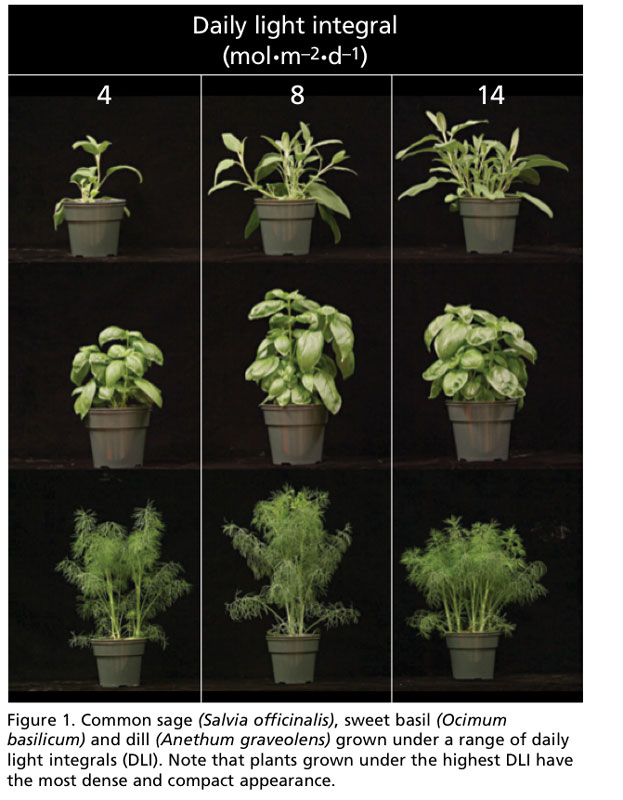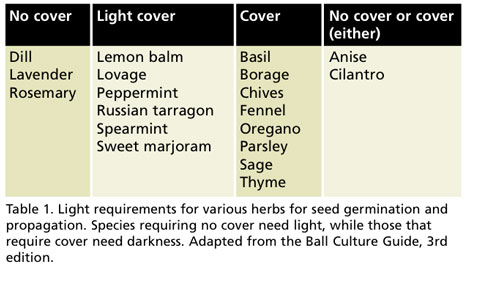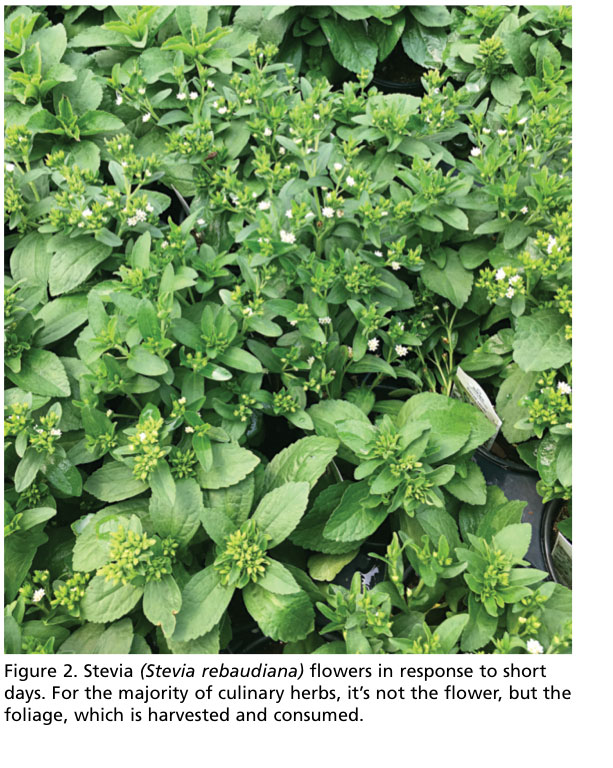10/1/2018
Managing Light
Christopher J. Currey
Containerized culinary herbs are produced and sold year-round. While there are some seasonal influences on production, such as certain herbs grown around Thanksgiving and Christmas or extra volume produced during the spring season, they’re much less seasonal than poinsettias or flowering bedding plants.
With 52 weeks of herb production each year, producers strive to produce consistent products throughout the year, as the amount of light and daylength varies. The focus of this article is on how to manage light when growing containerized culinary herbs, from propagation though finishing, so you can produce a consistent, quality crop.
 Managing light during propagation
Managing light during propagation
Before seeds are sown into plug trays or cuttings are stuck into the substrate, consider the light requirements for seeds and cuttings of your herbs. There are several reasons to manage light during propagation. First is going to be for uniform germination. Some species benefit from being covered during germination, while others prefer to be uncovered (the requirements for different species are summarized in Table 1).
Following radicle emergence, herb seedlings can start to stretch if grown under low light. Since there are no PGRs labeled for use on containerized culinary herbs intended for consumption, you’ll want to start suppressing unwanted stretch starting in propagation. Providing an additional 50 to 100 µmol•m–2•d–1 during propagation will help in minimizing unwanted stretch early in production. Additionally, the extra light will enhance shoot and root growth, making a higher-quality seedling and reduce the crop time for growing plugs.
In addition to lighting seedlings, shoot tip cuttings of herbs can also benefit from the same supplemental light during propagation when light levels are low after callus has formed. While photosynthetic light is typically maintained at lower intensities during propagation so as not to stress cuttings, these low-light intensities result in longer crop times for liners due to slow root growth, and increasing light enhances root growth and development.
Managing light for finishing
After transplanting plugs and liners in the containers they’ll be marketed in, it’s time to grow out and finish the herbs. During finishing, the quantity or intensity of photosynthetic light is going to be one of the primary environmental factors affecting containerized herb growth. A common saying is that “a 1% increase in light is a 1% increase in yield (weight).” While this actually varies across species, the sentiment is universal: as light increases, growth increases (up to a certain point).
There’s an important distinction that should be made for producing containerized culinary herbs versus those herbs that are fresh-cut and sold in bunches or in packages. Fresh-market herbs are usually sold by unit weight. For example, fresh-cut herbs are commonly sold in 3/4-oz. clamshells. Alternatively, containerized herbs aren’t sold by weight; rather, they’re marketed as individual units, i.e. a 4.5-in.
container.
Though increasing the growth (or weight) of your containerized herbs doesn’t directly increase the value of your sales due to greater shoot growth, there can be other benefits that may. First, herbs grown under higher light are more aesthetically appealing. The increased growth creates a dense appearance and fills in containers more quickly (Figure 1). Additionally, plants grown under high light also are more compact because they don’t stretch as much as herbs grown under lower light.
 The light requirements for many herbs haven’t been identified. However, based on those herbs that have been studied, herbs generally require moderate (10 to 20 mol•m–2•d–1) to high (>20 mol•m–2•d–1) daily light integrals (DLI) for good- to excellent-quality plants. From late spring until early fall, photosynthetic light is rarely limiting inside the greenhouse. However, as fall progresses, and throughout winter and early spring, photosynthetic light can be limiting inside a greenhouse.
The light requirements for many herbs haven’t been identified. However, based on those herbs that have been studied, herbs generally require moderate (10 to 20 mol•m–2•d–1) to high (>20 mol•m–2•d–1) daily light integrals (DLI) for good- to excellent-quality plants. From late spring until early fall, photosynthetic light is rarely limiting inside the greenhouse. However, as fall progresses, and throughout winter and early spring, photosynthetic light can be limiting inside a greenhouse.
During the light-limiting times of the year, supplemental light is useful to increase the DLI and subsequent containerized herb growth and finished plant quality. In addition to individual crop requirements, the exact amount of supplemental you’ll need to provide will depend on other factors, such as your geographic location and greenhouse glazing material. While it may not be practical or economical to provide supplemental light to reach 20 mol•m–2•d–1, setting a goal of providing 10 to 12 mol•m–2•d–1 between natural and supplemental light combined is more reasonable and will result in good-quality finished herbs.
 Managing light for flowering
Managing light for flowering
Just like many floriculture species, several herb species have a photoperiodic flowering response and will flower under specific daylengths. For example, dill (Anethum graveolens) and English lavender (Lavandula angustifolia) flower in response to long days, whereas stevia (Stevia rebaudiana) flower in response to short days (Figure 2). While the flowers of some herbs, such as chamomile (Matricaria chamomilla), are harvested for use, flowers are generally not desired for many culinary herbs; it’s foliage that we want.
For those herbs that are flowering during production, and whose flowering is controlled by the daylength, there are a few different options that you have. First, you can modify the photoperiod to create conditions that are non-inductive with respect to flowering. For short-day plants, long days can be created by providing 2 µmol•m–2•s–1 (~10 f.c.) as day-extension lighting from approximately sundown until 10:00 p.m., or as night interruption lighting from 10:00 p.m. until 2:00 a.m. For long-day plants, non-inductive short days can only be created by pulling black cloth over plants to block out light.
There’s another opportunity to produce containerized herbs with photoperiodic flowering responses without modifying the daylength. One strategy to reduce the total crop time for your containerized herbs and still sell a marketable container is to increase the number of plants in each container. Whether it’s using a single plug with multiple seedlings per plug or planting multiple plugs per container, your containers will fill in quicker due to the additional plants, reaching a marketable size before they flower.
Take-home message
Light plays an important role in the growth of all plants, including culinary herbs. Providing ample photosynthetic light from propagation through finishing during light-limited seasons will improve crop appearances and quality, and reduce overall production time. Additionally, even with a changing daylength throughout the year, there are strategies to control flowering of herbs with photoperiodic responses. GT
Christopher J. Currey (ccurrey@iastate.edu) is an assistant professor in the Department of Horticulture at Iowa State University.